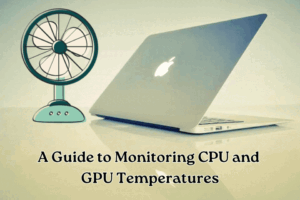A Guide to Monitoring CPU and GPU Temperatures
In today’s computerized age, where multitasking and requesting applications are commonplace, guaranteeing optimal performance of your Mac is crucial. One often-overlooked perspective of performance management is monitoring the temperatures of your Mac’s central processing unit (CPU) and graphics handling unit (GPU). In this comprehensive guide, we’ll dive into the significance of monitoring your Mac’s system performance, mainly focusing on CPU and GPU temperatures, and investigate different methods to do so effectively.

Why Monitoring Mac’s System Performance Matters:
Efficiently monitoring your Mac’s system performance is vital for several reasons. Firstly, it helps in identifying potential hardware issues before they escalate into major problems. Secondly, it ensures that your Mac operates within safe temperature ranges, preventing overheating, which can lead to performance degradation and even hardware damage. Lastly, monitoring system performance allows for proactive maintenance, prolonging the lifespan of your Mac and optimizing its performance over time.
Understanding CPU and GPU Temperatures:
The CPU and GPU are the workhorses of your Mac, responsible for executing tasks and rendering graphics individually. As they work, they generate heat, and maintaining optimal temperatures is significant for their proficiency in working. CPU and GPU temperatures are typically measured in degrees Celsius (°C) and demonstrate how hot these components run at any given time.
A Guide to Monitoring CPU and GPU Temperatures
ToggleMethods for Monitoring CPU and GPU Temperatures:
1. Built-in Mac Utilities: macOS provides built-in tools for monitoring system performance, including CPU and GPU temperatures. Applications like Activity Monitor and System Information provide insights into various system metrics, including temperature readings. While these tools offer basic monitoring capabilities, they may lack advanced features found in third-party solutions.
2. Third-Party Monitoring Software: For more comprehensive monitoring capabilities, third-party software solutions are available. Applications like iStat Menus, Intel Power Gadget, and HWMonitor provide detailed real-time monitoring of CPU and GPU temperatures, along with other system metrics such as fan speeds and power usage. These tools offer customizable dashboards and alerts, allowing users to tailor monitoring to their specific needs.
3. External Hardware Monitoring Devices:
Outside hardware monitoring devices can be utilized for users who require exact and persistent monitoring of CPU and GPU temperatures. These devices connect to your Mac via USB or Thunderbolt and provide real-time temperature readings through a dedicated computer program. Whereas more expensive than computer program solutions, hardware monitoring devices offer unparalleled precision and unwavering quality.
Best Practices for Temperature Monitoring:
1. Establish Baseline Temperature: Before delving into monitoring, it’s essential to establish baseline temperature readings for your Mac under normal operating conditions. This baseline serves as a reference point for identifying deviations and potential issues in the future.
2. Regular Monitoring and Analysis: Make monitoring CPU and GPU temperatures a routine part of your Mac maintenance. Regularly check temperature readings and analyze trends over time to detect any abnormal fluctuations or patterns indicative of underlying issues.
3. Optimize Cooling Solutions: Ensure that your Mac’s cooling system, including fans and ventilation, is clean and functioning correctly. Adequate airflow is essential for dissipating heat and maintaining optimal temperatures.
4. Adjust Performance Settings: Depending on your workload and performance requirements, consider adjusting your Mac’s performance settings to regulate CPU and GPU usage. Lowering performance settings can help reduce heat generation and improve thermal management.
Conclusion:
Monitoring your Mac’s system execution, mainly CPU and GPU temperatures, is essential for maintaining optimal performance and preventing equipment issues. By leveraging built-in utilities, third-party computer programs, or outside hardware checking devices, you can learn about your Mac’s warm health and take proactive measures to guarantee its life span. Joining temperature monitoring into your standard maintenance schedule will help keep your Mac running smoothly and efficiently for a long time.
Remember, a cool Mac is a happy Mac!
